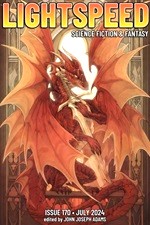“The Last Lucid Day” by Dominique Dickey
“Songs of the Sorrow of Thorns” by Amayah Perveen
“The Only Writing Advice You’ll Ever Need to Survive Eldritch Horrors” by Aimee Picchi
“The Red Queen’s Heart” by Vanessa Fogg
“The Heist for the Soul of Humanity” by Filip Hajdar Drnovšek Zorko
“A Guide on How to Meet the Deity of Many Faces” by Oyedotun Damilola Muees
“The Aliens Said They Wanted to Party” by Joel W. D. Buxton
“Between Above and Below” by Carrie Vaughn
Reviewed by Victoria Silverwolf
Seven short stories and one novelette appear in this issue.
In “The Last Lucid Day” by Dominique Dickey, a man has a difficult and ambiguous relationship with his elderly father, who is losing his memory. Flashbacks reveal the man’s painful childhood.
This synopsis does not mention the story’s speculative content, which is barely relevant to the plot. (A device allows the man to know when his father will have his last fully functional day.) Otherwise, this is a mainstream story with strong emotional appeal. It is narrated in second person, possibly in an attempt to have the reader share the man’s mixed emotions, but I felt this added little to the work.
“Songs of the Sorrow of Thorns” by Amayah Perveen is difficult to describe, as it is more of a prose poem and a mood piece than a plot-driven story. It has something to do with the protagonist overcoming adversity in a fantasy world, if I am reading it correctly. As with the previous work, it is written in second person, perhaps to make it seem more introspective.
Following the same pattern, “The Only Writing Advice You’ll Ever Need to Survive Eldritch Horrors” by Aimee Picchi is narrated in second person. In this case, however, this metafictional work is well aware of its own use of the technique. The main character is an accidental superhero secretly battling monsters from another dimension. What the story is really about is the breakup of a romance.
Besides mentioning second person narration, the story also openly discusses other writing techniques, such as flashbacks. (This is partially explained by the fact that the main character’s lover is a would-be writer.) The structure is unique, but runs the risk of distancing the reader from the work.
The narrator of “The Red Queen’s Heart” by Vanessa Fogg accepts parts of a woman’s heart in exchange for iron and ice. The woman goes on to rule a galactic empire. Years later, after bringing peace to the planets she conquered through war, she seeks to regain what she lost.
Despite the science fiction trappings, the story is pure fantasy. The symbolism of the lost parts of the woman’s heart is obvious. Despite the simplicity of the premise, the story is written well enough to hold the reader’s interest.
“The Heist for the Soul of Humanity” by Filip Hajdar Drnovšek Zorko is the magazine’s only novelette. Three unlikely partners are hired to steal an alien artifact. Each one has her own motive, as does the man who hired them.
I have deliberately given only a very vague description of the plot, as much of the story’s appeal comes from its many twists and turns. The futuristic elements are plausible and relevant, and the characters are complex. The author creates a great deal of suspense while taking the work in unexpected but logical directions.
As its title implies, “A Guide on How to Meet the Deity of Many Faces” by Oyedotun Damilola Muees consists of a set of instructions teaching the reader the proper way to approach a god, and warning of the many dangers along the way. The author reveals a rich and vivid imagination, but the story has no real plot.
“The Aliens Said They Wanted to Party” by Joel W. D. Buxton is a broad comedy in which very human extraterrestrials arrive on Earth, ready to have a good time with food, drink, drugs, music, and beautiful people. The last line turns the work into a mildly dirty joke. Some readers will find it more amusing than others.
The main character in “Between Above and Below” by Carrie Vaughn is an angel who journeys to a secluded place on Earth in order to avoid choosing sides in the war in Heaven. A human being arrives in the isolated mountain area, living like a hermit. The plot deals with their relationship and the reason the human left civilization.
This is a quiet, gentle tale that borders on sentimentality. The angel is an interesting character, the human not so much.
Victoria Silverwolf is working extra again.
 Lightspeed #170, July 2024
Lightspeed #170, July 2024